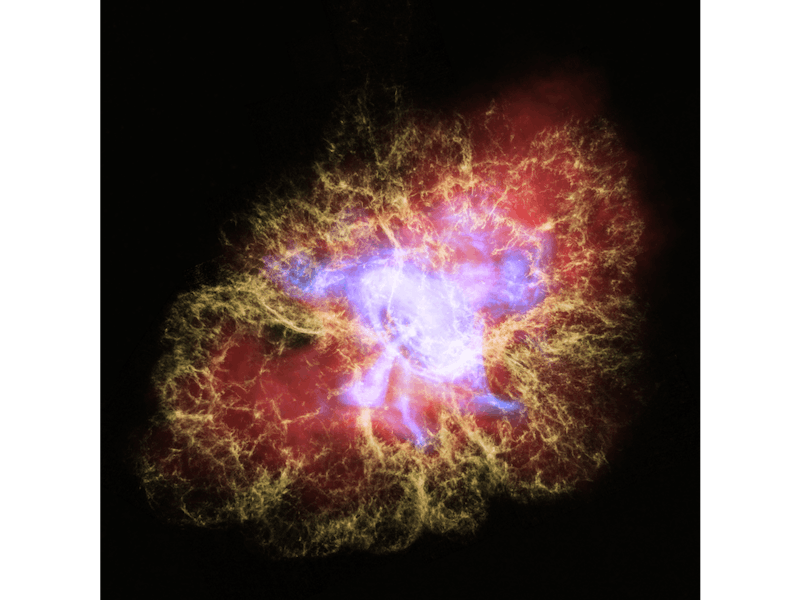Scientists unveil video of massive stellar explosion in the ancient universe
A new 3D visualization recreates the biggest stellar explosion observed by humankind -- and now you can watch it, too.

When a star dies, it produces a massive explosion known as a supernova, the remnants of which can be observed billions of light years away. These explosions are so consequential that a supernova is believed to have birthed the entire universe.
Using observations gathered by NASA, a team of astronomers have created the first three-dimensional visualization of one of the most famous supernova explosions ever observed by man — the Crab Nebula. The simulation accurately details all of its complex surroundings and gives us a fresh look at this ancient stellar explosion.
The resulting video shows a multiwavelength computer simulation that details the multiple layers that make up the Crab Nebula, from its fiery center that emits high-speed radiation to the outer web of gaseous filaments that surround the massive explosion.
You can watch the full video of the supernova here:
Crab Nebula: A history
This is no ordinary supernova. When it was first observed in the year 1054 AD by Chinese astronomers, the Crab Nebula was known as the “guest star,” as it was so bright that it appeared in the skies for 23 days during the daytime.
It was officially discovered by English astronomer John Bevis in 1731, although ancient astronomers in Asia, Native America, and the Middle East had noted the nebula in the sky long before that.
The Crab Nebula continues to fascinate astronomers, who have slowly detailed it through plenty of follow-up observations. William Parsons named it in 1840 after he observed that it has two tentacle-like figures on either side, while astronomers officially identified the cosmic structure as a supernova in the 1900s.
When it was first observed, the Crab Nebula appeared six times as bright as Venus and stretched as wide as six light years, according to NASA.
The supernova is located 6,500 light years away from Earth in the constellation Taurus, and has an apparent magnitude, or the measure of an object’s brightness, of 8.4. For comparison, Saturn’s largest moon Titan has an apparent magnitude of 8.2.
In the Crab Nebula's very center lies a pulsar: a neutron star as massive as the Sun but with only the size of a small town. The Crab Pulsar rotates about 30 times each second.
The center of the Crab Nebula houses a neutron star, left behind by the stellar explosion. This small star is about 19 miles across and emits 30 pulses of radiation per second in the form of twin beams on opposite sides of the star.
Filaments of gas surround the star in the shape of tentacles that extend outwards that are mostly made up of ionized oxygen, while a glowing cloud of gaseous emissions that remained from the initial explosion borders the entire star system with streams of charged particles.
Bringing a supernova to life
The 3D visualization was created using visible, infrared, and X-ray observations from the Chandra X-ray Observatory and the Hubble and Spitzer space telescopes.
“Seeing two-dimensional images of an object, especially of a complex structure like the Crab Nebula, doesn’t give you a good idea of its three-dimensional nature,” Frank Summers, visualization scientist at the Space Telescope Science Institute said in a statement.
“With this scientific interpretation, we want to help people understand the Crab Nebula’s nested and interconnected geometry. The interplay of the multiwavelength observations illuminate all of these structures. Without combining X-ray, infrared, and visible light, you don’t get the full picture.”
This image shows the Crab Nebula in infrared only, demonstrating how details of the explosion become lost without looking at multiple sources.
The visualization shows some of the ways the Crab Nebula differentiates from a classic supernova. Unlike regular a supernova, which is mostly made up of debris and a blast wave left over from the explosion, the Crab Nebula is a pulsar wind nebula.
Pulsar wind nebulae house lower-temperature gas in the inner region of their star systems. The gas is then heated by the radiation emitted from the pulsating star at the nebulas’ centers, causing them to reach thousands of degrees.
“It is truly via the multiwavelength structure that you can more cleanly comprehend that it’s a pulsar wind nebula,” Summers said.
“This is an important learning objective. You can understand the energy from the pulsar at the core moving out to the synchrotron cloud, and then further out to the filaments of the cage.”